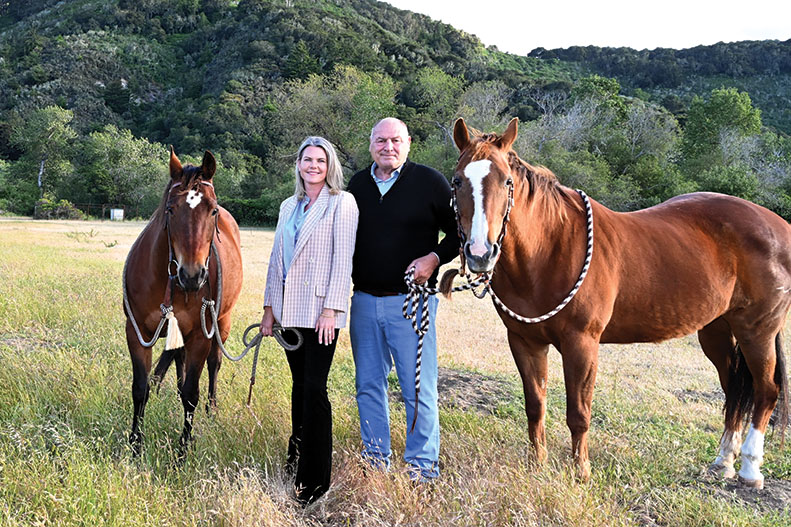
Carmel Valley residents Paul and Marta Kephart, along with their three children, embody the ecologically based lifestyle of their business, Rana Creek Habitat Restoration. On any given weekend, you might find the Kepharts camping on the land of their Carmel Valley nursery, rising early to collect eggs from their chickens and to care for their horses and sheep, checking on their plants, or greeting visitors curious about creating sustainable landscapes.
Founder Paul Kephart, the principal ecologist and designer at RANA, created his first “living roof” at
Big Sur’s famous Post Ranch Inn in the late 1980s.
RANA President and CEO Marta Kephart explains that ecologically designed building elements such as living roofs—typically planted with indigenous grasses and plants that are attractive to wildlife—help with keeping interior room temperatures stable while providing an environment for birds and butterflies.
Paul was also on the founding board of MEarth, an environmental learning system which is now part of the curriculum at Carmel Middle School. Located in Carmel’s Hilton Bialek Habitat, MEarth boasts an outdoor classroom set amongst native plants and a bee garden.
Also instrumental in the implementation of the “Return of the Natives” program at CSU Monterey Bay, Paul lent his expertise to the community based environmental education and habitat restoration program.
RANA recently celebrated its 25th year, and Marta shares that the company has evolved into four sectors with a global reach.
“We are a native plant nursery, and one of the largest native plant growers in the state,” she says. “We grow over 1,500 plants indigenous to California. We supply plants to the Facebook and Microsoft campuses, new state parks and local businesses.”
Another facet of the company is habitat restoration, such as an ambitious project assisting in taking out the unsafe and environmentally harmful San Clemente Dam on the Carmel River.
“We worked with a team to remove the dam and reroute the river,” she says. “Now we have steelhead trout in the river again.”
The other two sectors under RANA’s umbrella are landscape architecture and living architecture.
“We’ve had a lot of collaborations with the California Academy of Sciences in San Francisco,” Marta explains. “Our great team takes on about 200 projects a year, with a lot of park restoration, and coast side restoration with invasive species removal and bringing back the native habitat.”
Marta has been personally moved to assist with the revival of the endangered monarch butterfly population; RANA has grown over 100,000 native milkweed plants and partners with garden centers to increase pollinator plants throughout the state.
“The huge increase of monarch species awareness is exciting,” she says.
The benefits of designing with nature go two ways: while helping restore the environment, the environment can also restore humans.
“We just finished the Breast Care Center at Montage Health,” Marta says. “We take cues from nature in our design process. Studies have shown by including plants indoors and outdoors, patients heal up to 30% faster, especially if they can see nature out their window. It also improves indoor air quality and makes a respite for overworked doctors and nurses.”
Another recent project focuses on soothing animals: the Kepharts are working with a veterinarian in Eureka to create the Healing Spirit Animal Wellness Center, a holistic veterinary clinic that avoids the cold, sterile intimidating environment of most clinics.
“We are designing the clinic through a pet’s eyes,” Marta explains.
The Kepharts are now offering their own architectural work and are often being brought in as the concept architect for new contracts.
A project they completed at One Maritime Plaza in San Francisco involved creating 17 rotating hanging planted columns that are each 15 feet tall and located in the lobby of the office tower.
Global designs tackle challenges such as how to farm in contaminated soil in China. In Hangzhou, the task involved working on a 66-acre superblock and creating a 10-acre rooftop garden to grow coveted local tea in organic soil. Each project offers a unique set of environmental aspects to incorporate into the final product.
“It’s compelling design work, whether it’s for climate adaptation or to mitigate sea level changes,” Marta says.
Now, the Kepharts are looking forward to their next environmental adventure to make a global impact with two new business ventures—one of which, Nutjobs Inc., puts nutshell waste to good use.
“We are on a mission to transform nutshell waste into benign products to use as alternatives to plastic,” Marta explains. “There is over 8 billion pounds of agricultural waste from almond hulls and shells every year in California. We are really excited now to be able to produce pellets and packing peanuts that are 100% compostable.”
The Kepharts have also launched a bio-textile company known as Apparent Ventures, which tackles the multi-billion-dollar problem of invasive plant species in California.
“We are taking invasive plants in California and transforming them into textile fibers,” Marta shares. “The Arundo plant in Salinas Valley is responsible for up to 20% of the dewatering of the Salinas River. In Los Angeles County, the same invasive plant is taking up the equivalent water supply for over 3 million people. But it turns out the plant makes a very beautiful textile product.
“Living on the Monterey Peninsula is so conducive to creativity,” Marta says.
“We are so close to the high-tech Silicon Valley energy and those big visions, but we are also surrounded by all of this natural beauty,” Marta explains. “We work with farmers, the ag industry and the tourism industry. … Being here we get the best of both worlds.”
The RANA Nursery is located at 7495 Williams Ranch Road in Carmel. The main office is located at 27875 Berwick Drive in Carmel. For more information, please visit www.ranacohabitat.com or call 831/659-3820.